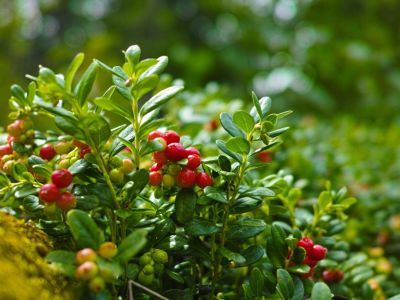What are Cranberry Plants?
Cranberry plants, or Vaccinium macrocarpon, are woody, low growing perennial vines. Native to the temperate zones of the east coast, the central U.S., and from southern Canada in the north all the way to the Appalachian mountain range in the south, cranberries are often harvested commercially in water, but contrary to popular belief, actually flourish when grown on dry land. Cranberry plants grow runners measuring from 1 to 6 feet (31 cm. to 2 m.) long with dark green, glossy leaves during its growth phase and reddish brown during the dormant season. Along the runners, short vertical branches develop and form flower buds jutting above the matted vines. From these branches, berries form.
How are Cranberries Grown and Can You Grow Cranberries at Home?
Commercially grown cranberries are often grown in bogs, which have evolved naturally from glacial receding, causing holes that over time filled with water and decayed matter. As mentioned above, however, growing cranberries can occur on dry land as well, provided there are a few requirements. Can you grow cranberries at home? Yes, and now the question is how are cranberries grown in the home garden? The first thing to determine how to grow cranberries is the pH of your garden soil. Cranberries are a member of the Ericaceae family and, as such, are best suited to a soil pH of less than 5. You will want to test your soil to determine pH and also make sure you have very well draining soil, or amend the soil with sand. The second major consideration when attempting cranberry vine care is irrigation. If you have very alkaline water, this will affect the pH of your soil and may render it unsuitable for growing cranberries. The final test, which answers the question, “Can you grow cranberries at home?” is to determine what the climate is like in your region. Cranberry plants need cold weather in order to trigger a dormant phase, approximately three months of temperatures in the 32 to 45 degree F. (0-7 C.) range. Some areas of the country will not be suitable for cranberry planting.
How to Grow Cranberries
When everything above is checked off your list, it’s time for the basics of cranberry vine care. Growing cranberry plants from seed is not recommended. Plants may be obtained through mail order, the Internet, or if you reside in an area of commercial cranberry farms, possibly from a grower. To make things easier, purchase rooted seedlings, which are usually in a 1 inch (2.5 cm.) diameter pot. Plant one rooted cranberry cutting per square foot, which should fill in within one or two years. It is unnecessary to put fertilizer in the hole as long as the rooted section is substantial. Plant cranberry plants after the last major frost in the spring depending on your location. Water daily for the first couple of weeks until the seedlings have established and thereafter every couple of days, or keep moist but not drenched. Fertilize every three to four weeks with slow release fertilizer and follow up regularly with a balanced liquid fertilizer.. Hand weed as needed. Protect cranberry vines from damage during winter conditions with a thick layer of mulch such as pine boughs. Snow accumulation may become a protector of sorts as well. Fruit of the cranberry plants will become apparent the year after planting, but more likely the second year depending on the number of pollinators visiting your cranberry plot.
